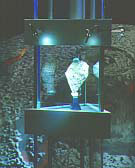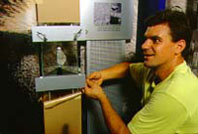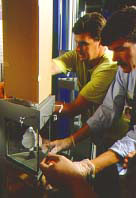
Lunar Sample 15555,880. A medium grained olivine mare basalt.
Janet Annenberg Hooker Hall of Geology, Gems, and Minerals
Opens September 20, 1997
At The Smithsonian's National Museum of Natural History
 Lunar Sample 15555,880. A medium grained olivine mare basalt. |
"The 20,000-square foot hall, closed since 1995 for the renovation, features the renowned Hope Diamond along with the museum's unparalleled collection of gemstones and jewelry pieces, including important new donations never displayed before. The exhibition also contains 2,500 minerals and gems in spectacular colors and shapes, about a third of which are on public view for the first time; a re-creation of four mines, lit by state of the art fiber optics, with dioramas that show how minerals appear underground; a major new exhibition on plate tectonics, demonstrating how the sliding and shifting of Earth plates cause earthquakes and volcanoes and showing the world's "hot spots"; and a gallery devoted to the Moon, meteorites and the solar system, where visitors will be able to touch meteorites, in addition to discovering Moon rocks and other out-of-this world objects."*
The Moon, Meteorite and Solar System Gallery is an exploration of the birth of our solar system and its evolution, through films, computer interactives and touchable specimens. This gallery features four lunar samples representing the lunar crust, mare basalts and impact breccias. They were mounted in triangular, glass prisms in nitrogen cabinets in the Lunar Sample Facility at NASA JSC. Although the samples had been prepared some months, the new display cases came together only shortly before the deadline, resulting in a massive team effort to get the displays ready in time. The displays were hand carried to Washington by four couriers who used charm, diplomacy and brute strength (the sample boxes are bulky and heavy) to personally convey the samples through airports and airplane. The couriers were met at Washington National Airport by Smithsonian curator Tim McCoy. The samples were received at the Smithsonian by Glenn MacPherson and staff who were eagerly awaiting their arrival. The lunar displays were mounted into the Smithsonian's gallery the following morning with appropriate ceremony!
The new exhibit is a wonderful showing of the world's most famous meteorites and examples of each meteorite class are set in the context of planetary evolution. For example, five-foot polished slabs of irons are not only beautiful, but serve to illustrate grain size variation. Planetary processes and interiors are enhanced by bringing field specimens into the exhibit hall - an actual K-T boundary section from Raton, New Mexico, and San Andreas fault cross-section are on display. The Smithsonian's planning and effort since 1989 has resulted in an excellent exhibit, which is worth a special trip to Washington to experience.
 |
 |
| Putting on the final touches to the new lunar sample display. | Final stages of sample display installation. |
 |
 |
| Glenn MacPherson (on right) is assisting in the installation of the lunar display sample. | Tari Mitchell and Andrea Mosie preview the exhibit. |
MacPherson sent his thanks to Jim Gooding for his assistance in the initial work and planning of this request, CAPTEM for their approval and Doug Blanchard and his staff.
*Information from a Press release from the Smithsonian Institute (NMNH)